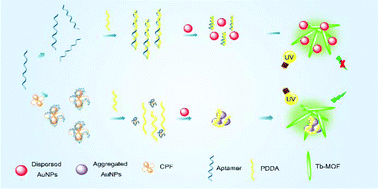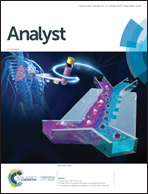Fluorescent aptasensing of chlorpyrifos based on the assembly of cationic conjugated polymer-aggregated gold nanoparticles and luminescent metal–organic frameworks†
Abstract
This study reports on a fluorescent aptasensor of chlorpyrifos (CPF) based on terbium(III) based on metal–organic frameworks (Tb-MOFs) and PDDA-aggregated-gold nanoparticles (AuNPs). The dispersed AuNPs quench the emissions of the Tb-MOF, while the PDDA-aggregated AuNPs have little effect. The aptamer interacts with PDDA via electrostatic interaction to prevent the aggregation of the AuNPs, which protects the AuNPs from PDDA-induced aggregation and the fluorescence of the Tb-MOF is quenched by FRET between the Tb-MOF and the dispersed AuNPs. Upon the addition of CPF, aptamers are exhausted to form a CPF–aptamer complex, and the following PDDA causes the aggregation of AuNPs, accompanied by weak quenching of the fluorescence of the Tb-MOF. This unlabelled strategy sensitively detects CPF at a concentration of 3.8 nM with a linear range of 5–600 nM. The assay is selective for CPF over other interfering compounds. The method was successfully applied to the determination of CPF in (spiked) tap water and vegetables and fruits samples, indicating its potential applications in enlarging the target scope of luminescent-MOF-based detection for environmental and agricultural samples.



 Please wait while we load your content...
Please wait while we load your content...